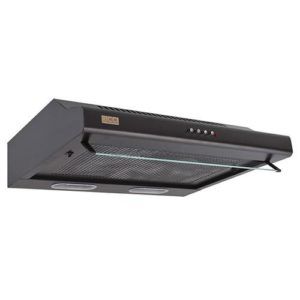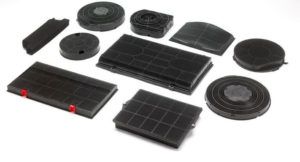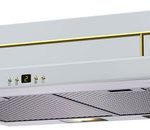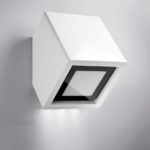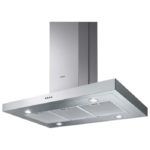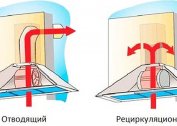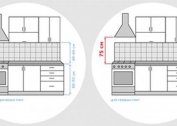In modern kitchens and homes it is not always possible to install an extractor hood in the kitchen, connecting it to the general home ventilation. There are many reasons for this, for example, with poor operation of the ventilation system or the low height of the walls of the room, which does not allow pipes to be laid. Sometimes the owners do not want to clutter up the kitchen space with ventilation pipes. After all, then the general ventilation hole disappears in the apartment, which gives air circulation throughout the room. In addition, the pipe leading to ventilation does not look very aesthetically pleasing on the kitchen wall.
In this case, exhaust devices that do not have an outlet to the ventilation ducts can help.
Principle of operation
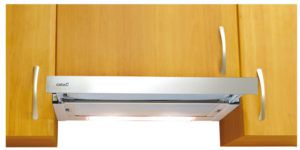 It is clear how exhaust hoods function with a vent through an air vent, it is clear: air contaminated with vapor is drawn into the hood by a special “pump” and leaves the kitchen through the air duct. And what is the principle of operation of such a device as an extract without exhaust air through the ventilation duct?
It is clear how exhaust hoods function with a vent through an air vent, it is clear: air contaminated with vapor is drawn into the hood by a special “pump” and leaves the kitchen through the air duct. And what is the principle of operation of such a device as an extract without exhaust air through the ventilation duct?
Everything is also elementary. Any exhaust system that does not have an outlet to the ventilation system operates by a recirculation method. In this device, dirty air enters, where the filtration system purifies it and takes it back to the room. This is how any hood works without a vent to ventilation, in a closed cycle.
Such exhaust structures have many advantages:
- space is saved;
- heat is not emitted from the apartment, which reduces energy consumption for space heating;
- affordable price;
- ease of installation.
Types of Filtration Systems
Since an exhaust device without an air duct has a whole system of filters in its structure, this type of filter is called filtration.
Most modern exhaust devices have a step configuration of filters. Here, the air first goes to the compartment, where it is cleaned of soot and greasy components. Then it is pulled into the second compartment, where other filtration structures free the air from unpleasant “aromas” and other impurities. After this, the cleaned air returns to the room.
The simplest in configuration and the cheapest in cost are exhaust designs with acrylic filters. They are intended for single use. After development, such a filter must be replaced.
In addition, exhaust devices having cleaning systems of this level are reusable. This type of device includes those that contain metallic filter systems in their structure. Metal filtering devices are very effective and last longer than acrylic analogues. Metal systems can be cleaned by simply rinsing them with water mixed with some kind of detergent or detergent. Sometimes they are lowered and washed in the dishwasher.
Second-level filtration devices are still produced in coal. They work great when cleaning air. This is possible due to the absorbing properties of coal, which absorbs all excess from the air. The disadvantage of these cleaning filters is the fact that they are not reusable. They serve a maximum of 5 months, although there are also those that can work longer. After all, the duration of their work depends on how much they cook on the stove and whether they smoke there.
- Metal filter
- Carbon filters
Cooker hoods
All hoods with filtration systems work on the same principle, although they are still divided into several subspecies. By type of installation, the hoods are divided into:
- flat;
- built-in;
- outboard;
- inclined.
The flat type fixture is a panel that is mounted above the surface of the plate perpendicular to the wall. This is the classic version and the easiest. The disadvantage is a rather weak motor. This type of exhaust device is best suited for small-sized kitchens in which long-term operation of the appliance is not required. These hoods include Minola HPL 511 I, Liberton LHW 53-1 IX, FREGGIA CHX15X and others.
Built-in fixtures are mounted inside furniture cabinets and hung above the stove. Such types of exhaust structures, as a rule, are compact and hardly noticeable. They can only be seen by looking from the bottom to the bottom of the cabinet suspended above the stove. Such hoods have a more powerful motor. Here's an example of a kitchen hood design like the Cata TF-2003 inox.
The suspended type of devices without an air duct differs from the built-in ones in that such structures are not mounted inside the furniture, but are located directly under it. This saves kitchen space and rational placement of kitchen furniture. Their difference is that the working part of the hood surface can be increased by the extension method. An example of such a device is the KRONA MILA 500 white / gold 3P. In the photo just such a hood is depicted.
Inclined devices are the most advanced right now. True, they are rarely found in just such an option. They are rarely released with filters. Such devices are suspended at an acute angle to the walls. Their advantage is silent operation. That is why hoods to the kitchen without venting into the ventilation are becoming more and more semi-popular. This is how the slanted hood in the interior looks so beautiful.
- Minola HPL 511 I
- CATA P-3060 inox 65533
- KRONASTEEL MILA 600 white / gold 3P
- MAUNFELD Trent Glass 90
Classification by installation type
Install ventilation devices in many ways.
Wall models are mounted on the wall.
Island hoods are installed as a separate module above the surface of the stove. They are more suitable for large kitchens. Or even in cafes, restaurants and other rooms. And in apartments, island exhaust devices are installed very rarely. But such a hood has advantages in large houses in that you can install it with a stove anywhere in the kitchen.
Corner hoods are more suitable for small kitchens, as they are often mounted on wall joints and in corners to save space in the kitchen. The model and design are selected so that everything looks like a single ensemble.
- Wall
- Island
- Corner
Additional functions
Hoods often have auxiliary capabilities. Most often they are installed on:
- backlight;
- Automation, so that the device turns on itself as soon as the oven turns on;
- a timer so as not to wait for the complete purification of the air;
- remote control.
In modern hoods, sensors, weather displays, sensors are often installed, indicating the operation parameters of the hood and so on. On some range hoods electronic reminders for housewives are installed.
How to choose the right
First of all, you need to consider how much power is needed. It is necessary for this to determine the amount of air in the kitchen, multiplying the height, length and width. The result is multiplied by 12. This is an indicator of the required performance.
In size, the exhaust device should not be smaller than the surface of the stove. Well, you need to take into account the noise produced.
So the choice of the exhaust device depends on the tastes and money of the homeowners, where it is planned to install the hood.
